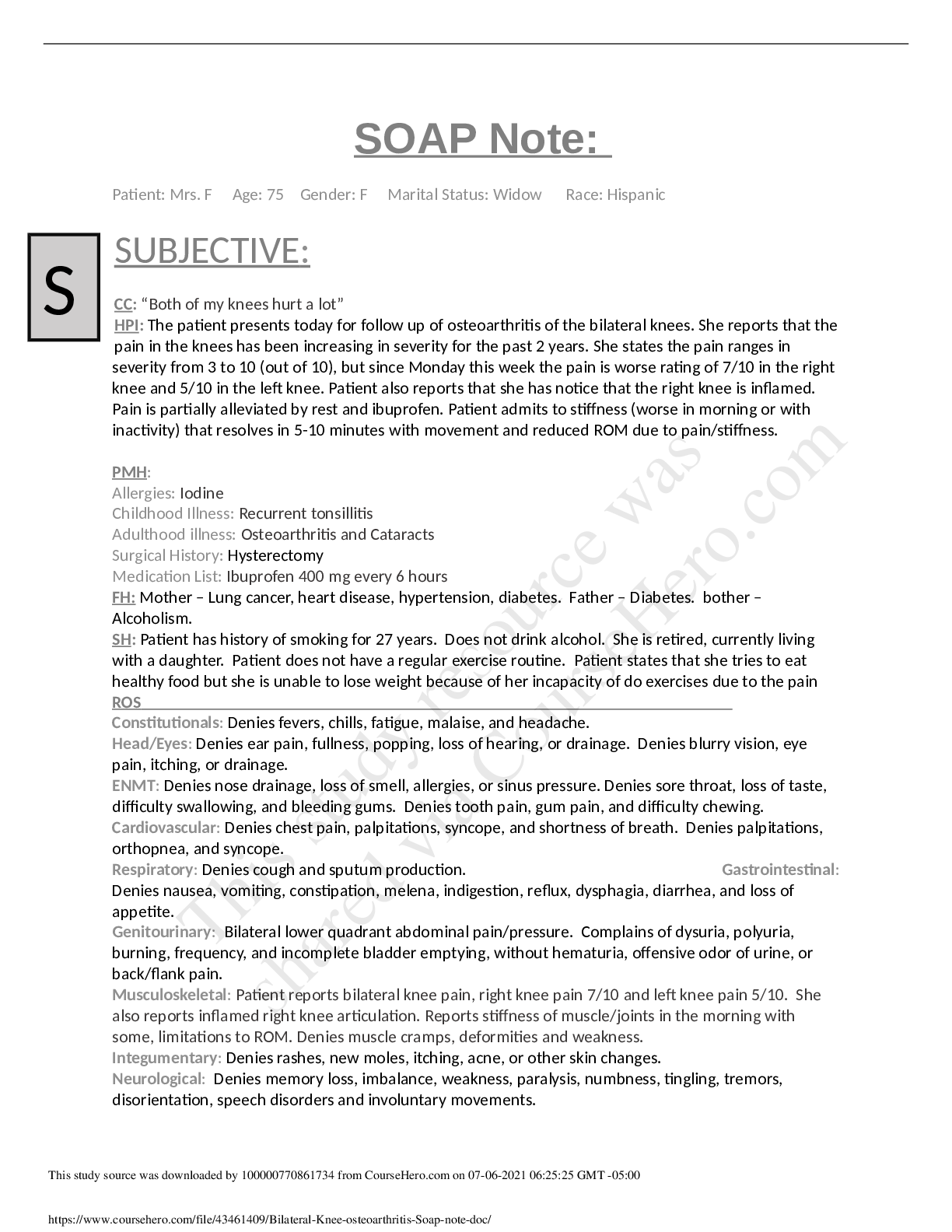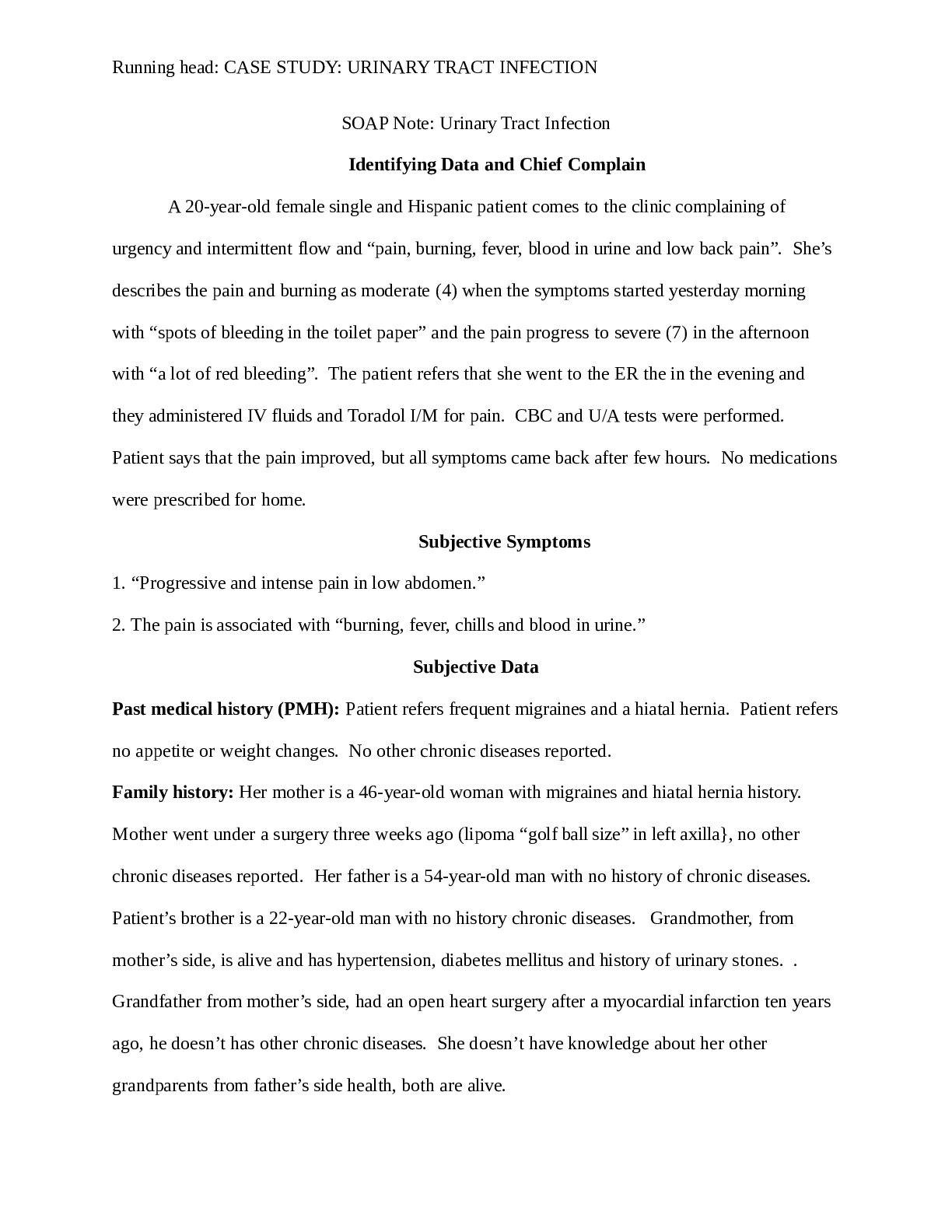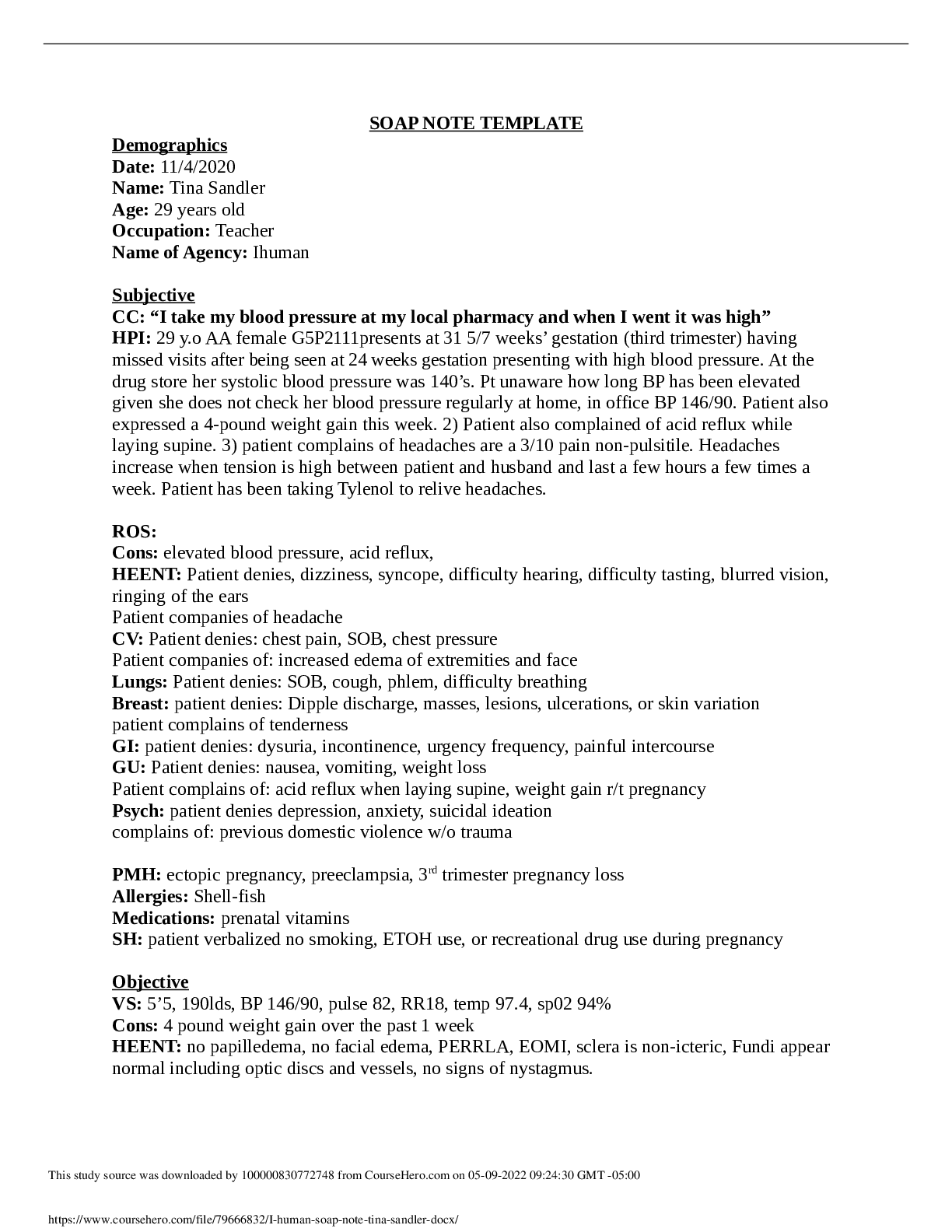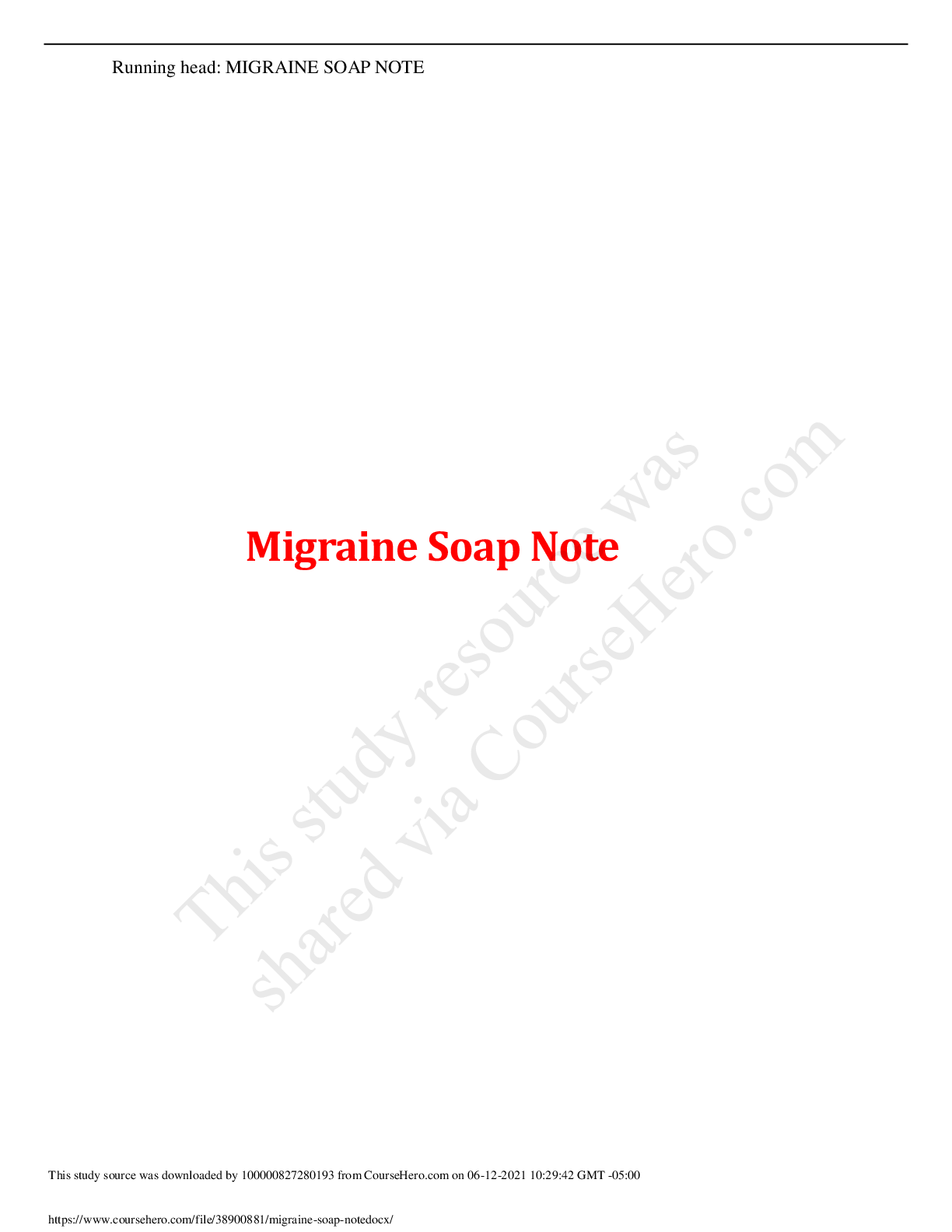NURSING 812 Psoriasis SOAP Note Sample- Critique | (Already Graded A)
Document Content and Description Below
Psoriasis SOAP Note Critique “On my honor as a student, I have neither given nor received aid on this assignment.” Vitals The UVA Dermatology Department does not take vital signs. Chie... f Complaint: Follow up evaluation of psoriasis Subjective: This is a pleasant 18 year old male, who presents today at the Dermatology Clinic for evaluation of psoriasis. It appears that he was last seen in Dermatology Clinic approximately a year and half ago. At that time, he was noted to have a flare up of his psoriasis after receiving systemic prednisone for an asthma attack. He was prescribed Soriatane 25 mg daily as he responded well in the past. He did not fill this medication partially because of financial constraints; in addition, he was concerned about drinking while at school. He has not used any topicals recently. As he could not fill the Soriatane, he was given a prescription of Keflex and Dovonex, which he used in conjunction for some period of time. This led to some improvement; however, he continues to have quite significant psoriasis. He notes that his main concerns is that of pruritus. He is also bothered by the erythema and scaling of his skin. The patient denies any joint swelling or joint pain. He states that he has otherwise been in good health. He is currently using just over the counter lotions for his psoriasis. Past Medical History: Asthma Psoriasis Medications: Albuterol Inhaler Family History: No know family history of skin cancer. He does have a history of psoriasis in an uncle and eczema in his sister. Deletions/Revisions: 1. I did not document a review of systems. a. I should have documented formally that the patient is generally in good health, by stating “negative review of systems.” Instead I briefly mentioned him being in good health in the history of presenting illness. The review of systems may uncover problems that the patient has overlooked, particularly in areas unrelated to the chief complaint (Bickley & Szilagyi, 2009). b. Legally, it is important to document review of systems for payment of services rendered. Health professionals who don't comply with the guidelines or the claims review process will be denied payment for the billed service (Centers for Medicare & Medicaid Services, 1997). For the problem-pertinent ROS such as the one presented, the documentation must show the patient's positive responses and pertinent negatives for the system related to the problem identified in the HPI (Centers for Medicare & Medicaid Services, 1997). 2. I did not inquire about the onset of original flare up, nor did I specifically date and time of recent flare up. Nor did I document, that his psoriasis got better in the summer. a. When obtaining a history, it is useful to determine the age of onset as younger age of onset and positive family history have been associated with more widespread and recurrent disease (Gudjonsson & Elder, 2008). 3. I did not inquire about the type of OTC medications he had been using. Nor did I add it to the medication list. a. “Medications should be noted, including name dose, route, and frequency of use” (Bickley & Szilagyi, 2009). The reconciliation of medications helps to tease out what may be the root of a patient’s illness or clinical presentation. 4. The prior course of disease was not documented for this patient. Inquiring about the prior course of disease, helps to establish patterns and guide treatment. a. Patients who frequently experience relapse tend to develop more severe disease and require more aggressive therapy; therefore, for prognostic implications, it is important to get a thorough history of the disease (Levine & Gottlieb, 2009). 5. This patient is a freshman in college. Being a freshman 4 hours away from home in a new environment could cause stress. His self – esteem or confidence may be diminished because of the unattractive skin lesions all over his body. I should have inquired about his social history more or assessed his feeling about how he’s adjusting in school. a. Lesions can cause decreased concentration, impaired sleep and/or generalized discomfort (Johnson & Armstrong, 2012). b. Associations of psoriasis with smoking and alcohol should prompt clinicians to inquire regarding social factors (Johnson & Armstrong, 2012). OBJECTIVE General: Alert, oriented, appropriate, cooperative with the exam. Well – dressed, well – nourished African American male in no acute distress. Head/Face: Plaque involvement diffusely on his central face with erythema and scaling. Diffuse involvement of his scalp and preauricular cheek. Skin: Sharply demarcated erythematous and thin plaques covering 80% of his bilateral upper extremities and trunk. Deletions/Revisions: 1. I did not document that I observed pityriasis capitis. a. It is one of the reasons why we prescribed Wilson’s Wonder as it helps with seborrhea along with psoriasis. 2. I should have documented the lesions as so: “well – demarcated, raised, erythematous plaques with a white scaly surface located primarily on the extensor surfaces of the body, involving 80% of body surface area” (Gudjonsson & Elder, p. (unknown), 2008). 3. The lesions were mostly symmetric in nature, which is tale tell sign of plaque psoriasis. a. “Psoriasis usually presents with symmetric, well – demarcated, erythematous plaques with overlying silvery scales, often with accompanying pruritus” (Levine & Gottlieb, p. 1293, 2009). 4. It was not mentioned if there was the presence of the Auspitz sign (bleeding points on the lesion after the scale has been scratched off). This patient had multiple areas on his body presenting with the Auspitz sign. 5. Did not address if there was nail involvement. The patient did not have any nail involvement. ASSESSMENT Differential Diagnoses • Plaque Psoriasis (confirmed) – patient has psoriasis involving 80% of his total body surface area 1. “Psoriasis is a chronic inflammatory skin disease, with a strong genetic basis, characterized by complex alterations in epidermal growth and differentiation and multiple biochemical, immunologic, and vascular abnormalities” (Gudjonsson & Elder, p. (unk), 2008). It is important to acknowledge that the patient had a family history. 2. The diagnosis of plaque psoriasis is mainly clinical. Diagnostic guidelines for the non - dermatologist include: a. Characteristic morphology of erythema, scaling, and induration. b. Scalp involvement. c. Nail involvement (pitting, onycholysis, crumbling, or oil spots). d. Involvement of the intertriginous folds. e. Family history of psoriasis (Johnson & Armstrong, 2012). This patient presents to the clinic with 3 out of five diagnostic criteria. • Discoid/Nummular Eczema (refuted) – The lesions of discoid or nummular eczema are thinner than the plaques seen with psoriasis. This patient had thick, erythematous plaques all over his body. Although, plaque psoriasis may resemble eczema, plaque psoriasis lesions are thicker, redder, and more sharply demarcated (Levine & Gottlieb, 2009). Nummular eczema appears to have a papulovesicular peripheral border distinguishing it from plaque psoriasis. This patient does not have eczema because his lesions appear crusty, have a scaling surface, lack central clearing and he has no history of eczema (Halberg, 2011). Despite a history and family history of asthma which is associated with eczema, the lesions on this patient’s body are just too specific toward plaque psoriasis. • Seborrheic Dermatitis – The diagnosis of seborrheic dermatitis is mostly clinical. This skin condition is rare in African Americans (Naldi & Rebora, 2009). Although, patients with seborrheic dermatitis get better in sunlight, the lesions and distribution of lesions on this patient’s begs to rule seborrheic dermatitis out. Typically with seborrheic dermatitis, the lesions are erythematous with a yellowish hue and are covered with large greasy scales that can be detached easily. Lesions on the scalp may vary from dry scales (dandruff) to yellow, greasy scales and erythema (Naldi & Rebora, 2009). • Cutaneous T – Cell lymphoma (Mycosis Fungoides) (refuted) – this disease can produce plaques that resemble psoriasis. Due to the symmetrical distribution of the lesions one can rule this out. He also does not present with systemic symptoms that indicate lymphoma. He also has responded to treatment quite well in the past for his psoriasis. Besides pruritic, scaly plaques, this disease are associated with hypo- or hyperpigmented lesions, petechiae, poikiloderma, and alopecia with or without mucinosis (Usatine & Nayar, 2009). We know from the patient history that he has responded to treatment before. Mycosis fungoides would not respond to typical treatment used for psoriasis (Bolognia & Braverman, 2012). A skin biopsy would be needed if the patient fails to respond to treatment. • Cutaneous Systemic Lupus Erythematosus (refuted) – This disease tends to be exacerbated by exposure to sunlight and can leave scarring. This is not case with the presenting patient. The patient states his psoriasis gets better in the summer. Cutaneous SLE does similar to plaques psoriasis because the lesions are annular erythematous plaques. Through the history we can determine if the patient’s skin is photosensitive because cutaneous SLE can be exacerbated by exposure to sunlight and leave scarring (Naldi & Rebora, 2009). This patient denies any reports of this phenomenon. This patient feels he is generally in good health. He does not report evidence of systemic illness that with lupus. However, to officially rule cutaneious SLE out, a skin biopsy can be useful (Naldi & Rebora, 2009). • Lichen planus (refuted) – This disease is more distributed on the flexor surfaces and around the wrists and ankles rather than elbows and knees. The clinical presentation does not completely align with the 5 Ps of lichen planus, “planar, purple, polygonal, pruritic and papular” (Usatine & Nayar, 2009). Along with these characteristics, the lesions also display lacy, reticular white lines. Lichen planus tend to have greater involvement of the mucous membranes (Johnson & Armstrong, 2012). Labs Usually, the diagnosis of plaque psoriasis is made based on clinical presentation. However, it would be prudent to check his lipids as we did during this clinic visit. 1. Psoriasis patients can have abnormal lipid levels. Patients with psoriasis were shown to have 15 percent higher levels of high-density lipoproteins, and 19 percent higher cholesterol-triglyceride ratios for very low-density lipoprotein particles (Gudjonsson & Elder, 2008). 2. Before prescribing Soriatane, we must obtain a baseline CMP (which includes a liver panel) because, although, rare Soriatane can lead to liver problems (www.medscape.com) PLAN/TREATMENT Multiple treatment options were discussed with the patient and his father. We discussed phototherapy, systemic treatment such as Soriatane and methotrexate, and topical therapy. As the patient responded well to Soriatane in the past, he is interested in reinstituting treatment with Soriatane. Soriatane 25 mg tablets by mouth once daily Calcipotriene (Dovonex) 0.005% cream apply to psoriasis daily in addition to Wilson’s Wonder (coal tar – salicyclic acid – triamcinolone) to use on his body. For his scalp, he was given a prescription for clobetasol 0.05% solution. For his face, desonide 0.05% cream apply topically daily We did discuss the use of phototherapy because the patient would be an excellent candidate for it. We obtained CMP, CBC with Differential and Lipid Panel Deletions/Revisions: 1. We should have advised the patient on some non – pharmacological interventions to help treat his associated symptoms. a. Daily baths in warm water followed by the application of a cream or ointment moisturizer may benefit psoriasis patients (Ferri, 2012). 2. Research has indicated Dovonex in combination with betamethasone efficacious towards clearing psoriasis or markedly improving it. Maybe instead of clobetasol, we should have used betamethasone in conjunction with Dovonex to improve patient outcome. This is especially since his case is so severe. a. “In a 4-week trial of patients with mild to severe plaque psoriasis, 48% of patients treated with the combination agent achieved absent or mild psoriasis, compared with 16.5% of patients treatment with calcipotriene once daily, 26.3% of patients treated with betamethasone once daily, and 7.6% of patients treated with placebo. A 52-week clinical practice dosage study showed 70% to 80% of patients achieving clear or almost clear status with no drug-related serious adverse events” with the combination of calcipotriene and betamethasone ointment ( (Menter, et al., 2009). EDUCATION I am embarrassed to acknowledge there was no documentation of education this SOAP note. It is important to document that education was done for the patient and his father. Lack of education can lead to non – compliance or complications regarding therapy. Deletions/Revision: 1. We didn’t really educate the patient about the importance non – adherence or medication side effects. a. Frustration with medication efficacy and inconvenience can lead to non – adherence of medication regimen (Menter, et al., 2009). b. Abrupt withdrawal of therapy should be avoided, as flares may result ( (Menter, et al., 2009). 2. We did talk to the patient about how treatment results were not fast. We educated about being patient when waiting for lesions to decrease or disappear, although it was not documented that we did such a thing. I’m disappointed because we were not very specific as to time. We also failed to mention to him or in the documentation that patient was educated about the disease process and prognosis. a. The scales of psoriasis improve after the initiation of treatment, but it may take 2 – 6 weeks for the affected areas of the skin to return to normal thickness. The redness may take up to several months to improve (American Academy of Dermatology, 2012). 3. We also didn’t educate the patient enough about the benefits of phototherapy (PUVA). a. Studies are showing the benefits of phototherapy. Data shows a significant improvement of psoriatic lesions in patients who have more sun exposure. Ultraviolet light has anti - proliferative and anti - inflammatory effects on psoriatic plaques (Levine & Gottlieb, 2009). b. Phototherapy is very effective in the majority of patients with severe psoriasis who possess the potential for long remissions (Levine & Gottlieb, 2009). 4. The National Psoriasis Foundation is a good source of information for patients with psoriasis. We should have encouraged the patient to peruse the website. REFERRAL The patient goes to school in Norfolk, which is extremely close to Eastern Virginia Medical School and could potentially get phototherapy there while in school for the rest of the semester. We discussed the risk and benefits of phototherapy and believed the patient could potentially be treated with phototherapy instead of systemic medications including Soriatane or methotrexate. We will refer him for evaluation at Eastern Virginia Medical School/Sentara Norfolk General Hospital. FOLLOW UP The patient will return the dermatology clinic in 1 months’ time or sooner should he have difficulty with the treatments outlined above. This patient’s labs came back later that day and he had elevated AST and ALT levels. We educated the patient and his father to delay use of Soriatane until the patient has abstained from alcohol for a month and he comes back (in 1 month) to get labs drawn again. For now, he will be using topical steroids and phototherapy until reevaluation. This patient is a college freshman. For most undergraduate students, part of the social culture is to binge drink alcohol. It is evident in his liver function tests that he is drinking too much alcohol. More emphasis needed to be placed on the importance of abstaining from alcohol. Alcohol can precipitate exacerbations and/or prolong duration of symptoms. Revision/Deletions: 1. There is some evidence of correlation between alcohol consumption and psoriasis severity (Menter, et al., 2009). 2. The consumption of alcohol may trigger psoriasis by impairing skin barrier function and altering immune function and keratinocyte activity (Johnson & Armstrong, 2012). CPT Code and ICD – 9 Code: Psoriasis [696.1U] Encounter for long – term (current) use of other medications [V58.69] Office Visit – Office or other outpatient visit for the evaluation and management of an established patient, which requires at least 2 of these 3 key components: An expanded problem focused history; An expanded problem focused examination; medical decision making of low complexity. Counseling and coordination of care with other providers or agencies are provided consistent with the nature of the problem and the patient’s and family’s needs [99213] References American Academy of Dermatology. (2012). Psoriasis. Retrieved March 14, 2012, from American Academy of Dermatology: Excellence in Dermatology: http://www.aad.org/skin-conditions/dermatology-a-to-z/psoriasis Bickley, L., & Szilagyi, P. (2009). Guide to physical examination and history taking. Philadelphia: Lippincott, Williams & Wilkins. Bolognia J.L., Braverman I.M. (2012). Chapter 53. Skin Manifestations of Internal Disease. In D.L. Longo, A.S. Fauci, D.L. Kasper, S.L. Hauser, J.L. Jameson, J. Loscalzo (Eds), Harrison's Principles of Internal Medicine, 18e. Retrieved March 15, 2012 from http://www.accessmedicine.com/content.aspx?aID=9098286. Centers for Medicare & Medicaid Services. (1997). 1997 Documentation guidelines for evaluation and management services. Retrieved March 12, 2012, from CMS.gov: http://www.cms.gov/MLNProducts/Downloads/97Docguidelines.pdf Ferri, F. (2012). Psoriasis. In F. Ferri, Ferri's clinical advisor 2012: 5 books in 1 (pp. 845 - 846). Philadelphia: Elsevier Mosby. Gudjonsson J.E., Elder J.T. (2008). Chapter 18. Psoriasis. In K. Wolff, L.A. Goldsmith, S.I. Katz, B.A. Gilchrest, A.S. Paller, D.J. Leffell (Eds), Fitzpatrick's Dermatology in General Medicine, 7e. Retrieved March 12, 2012 from http://www.accessmedicine.com/content.aspx?aID=2983780. Halberg, M. (2011). Nummular Eczema. The Journal of Emergency Medicine, 1 - 2. Johnson, M., & Armstrong, A. (2012). Clinical and histologic diagnostic guidelines for psoriasis: A critical review. Clinical Reviews in Allergy and Immunology, 1 - 7. Levine, D., & Gottlieb, A. (2009). Evaluation and management of psoriais: A internist's guide. Medical Clinics of North America, 1291 - 1303. Menter, A., Korman, N., Elmets, C., Feldman, S., Gelfand, J., Gordon, K., et al. (2009). Guidelines of care for the management of psoriasis and psoriatic arthritis. Journal of American Academy of Dermatology, 643 - 659. Naldi, L., & Rebora, A. (2009). Seborrheic dermatitis. The New England Journal of Medicine, 387 - 396. Nayar A., Usatine R.P. (2009). Chapter 169. Mycosis Fungoides. In R.P. Usatine, M.A. Smith, H. Chumley, E. Mayeaux, Jr., J. Tysinger (Eds), The Color Atlas of Family Medicine. Retrieved March 12, 2012 from http://www.accessmedicine.com/content.aspx?aID=8208326. [Show More]
Last updated: 2 years ago
Preview 1 out of 11 pages

Buy this document to get the full access instantly
Instant Download Access after purchase
Buy NowInstant download
We Accept:

Reviews( 0 )
$15.00
Can't find what you want? Try our AI powered Search
Document information
Connected school, study & course
About the document
Uploaded On
Jun 12, 2021
Number of pages
11
Written in
Additional information
This document has been written for:
Uploaded
Jun 12, 2021
Downloads
0
Views
202


.png)









